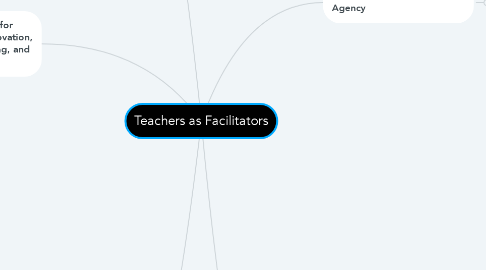
1. Tips for Integrating Tech
1.1. Don't fix what's not broken
1.2. Make things better when you can
1.3. Have a non-tech Plan B
1.4. KISS: Keep it Smart and Simple
1.5. Establish "acceptable use" rules in the classroom
1.6. Move around the classroom constantly. You're not monitoring or assessing so much as being the source of accountability.
2. Create opportunities for problem-solving, innovation, computational thinking, and design processes.
2.1. Game-based learning
2.2. Blended learning
2.3. Computational Thinking
2.3.1. Process
2.3.1.1. You can teach these skills individually and integrated. They don't have to be in the context of a problem or technology.
2.3.1.1.1. Put a jumbled story in the correct sequence
2.3.1.1.2. Identify patterns for sentence types and rules of grammar
2.3.1.1.3. Arrive at conclusions based on the given facts
2.3.1.1.4. Write a Choose Your Own Adventure
2.3.1.1.5. Model algebraic functions in programs
2.3.1.1.6. Write an algorithm on how to perform a mathematic function
2.3.1.1.7. Use decomposition to solve word problems
2.3.1.1.8. Do a species classification with If-Then logic
2.3.1.1.9. Build a computational model of a physical phenomenon
2.3.1.1.10. Create computational models and simulations to study phenomena
2.3.1.1.11. Study data and identify patterns
2.3.1.1.12. Create visualizations of patterns and trends
2.3.1.2. 1. Decomposition: what are the parts of the problem?
2.3.1.3. 2. Pattern recognition
2.3.1.4. 3. Abstraction: what are the forces behind these patterns?
2.3.1.5. 4. Algorithm design: finding a solution that could solve similar problems
2.3.2. Teaches students how to face complex and open-ended problems
2.3.3. Teaches positive attitudes towards potential problems
2.3.3.1. Tenacity
2.3.3.2. Confidence
2.3.3.3. Experimentation
2.3.3.4. Curiosity
2.3.3.5. Collaboration
2.3.3.6. Creativity
2.3.4. Emphasizes higher-order thinking skills
3. Encourage Creativity
3.1. Why?
3.1.1. It's one of the only ways to prepare for a future we know little about
3.1.2. There are more talents that are important than those we focus on in school, and they need to be encouraged as well
3.1.3. Creativity can be used in all walks of life
3.1.4. The brain isn't divided into compartments
3.1.5. Teaches to challenge ideas
3.1.6. Builds self-expression, autonomy, and collaboration
3.2. Originality requires risk-taking
3.3. Don't stigmatize mistakes. Instead, teach that mistakes are stepping stones
3.3.1. Stop punishing mistakes
3.3.2. Stop making mistakes scary
3.3.3. Stop making mistakes feel permanent
3.4. Say "yes" as often as you can
3.5. Model and encourage positive attitudes towards adversity
3.6. Say "what if" a lot
3.7. Ambiguity is not our enemy, nor is it a permanent state
3.8. Open play!
3.9. Use tasks that require divergent thinking (most assignments and assessments require convergent thinking)
3.10. Allow plenty of time for creativity
3.11. Encourage curiosity
4. Classroom Culture of Student Agency
4.1. Option 1: be an advocate for a cultural education change
4.2. Option 2: make the changes yourself
4.2.1. Know your students' abilities, interests, and readiness
4.2.1.1. Record individual observations
4.2.1.1.1. ClassDojo
4.2.1.1.2. Bloomz
4.2.1.1.3. Trello
4.2.1.1.4. Sticky notes and a notebook
4.2.1.1.5. Etc.
4.2.1.2. Be emotionally aware
4.2.1.2.1. Students can't learn if their emotional needs are not taken care of
4.2.1.3. Teach students to be emotionally aware
4.2.1.3.1. Give students places to express themselves (not only in language, but that's important)
4.2.1.3.2. Make your emotional curriculum fit their needs
4.2.1.3.3. Example curriculum:
4.2.1.3.4. Initiate discussion with stimulus
4.2.2. Differentiate
4.2.3. Give students ownership of their education
4.2.3.1. Self-directed learning
4.2.3.2. Inquiry projects
4.2.3.3. Emphasize skills and process, not product
4.2.3.4. I do - We do - You do scaffolding
4.2.3.4.1. https://techintegrateed.weebly.com/uploads/9/5/2/7/9527067/screen-shot-2017-07-10-at-12-14-05-pm_orig.jpg
4.2.3.5. Let students choose their method of assessment
4.2.3.6. Say "Yes" as often as you can
4.2.4. Why do students like games?
4.2.4.1. Choices! So many choices.
4.2.4.2. You start at 0 and go up, not start at 100% and go down
4.2.4.3. Encourages self-direct learning, perseverance, creativity, collaboration, and more
4.2.4.4. Gaming outperforms textbooks every time
5. Resources (See Google Keep for links)
5.1. ClassDojo
5.2. Bloomz
5.3. See PDF in Classroom Culture thread
5.4. TimerTab
5.5. CodinGame
5.5.1. Teach how to code through gaming
5.6. GWiki
5.6.1. Removes links from things you're trying to Copy-Paste. Put the url in the GWiki, then copy that.
5.7. Instructables
5.7.1. DIY projects
5.8. WeTransfer.com
5.8.1. transfers large files online
5.8.2. No login required
5.8.3. Doesn't remove the original file, just copies and sends it
5.9. Moovly.com
5.9.1. Make professional-looking videos
5.9.2. Paid product, but there's a free version under Education

